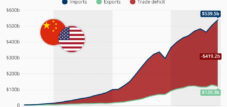Trump and Xi Jinping meet in South Korea – A historic summit with far-reaching consequences: What was the meeting about?
Xpert pre-release
Language selection 📢
Published on: October 30, 2025 / Updated on: October 30, 2025 – Author: Konrad Wolfenstein

Trump and Xi Jinping meet in South Korea – A historic summit with far-reaching consequences: What was the meeting about? – Image: Xpert.Digital
Trump celebrates "12 out of 10" deal with Xi – but experts see a clear winner
From trade war to sensation: What Trump and Xi really agreed on – why the world is now breathing a sigh of relief
On October 30, 2025, US President Donald Trump and Chinese President Xi Jinping met in Busan, South Korea, for their first face-to-face meeting in six years. The meeting took place on the sidelines of the Asia-Pacific Economic Cooperation (APEC) summit and lasted approximately one hour and 40 minutes. It was the first direct encounter between the two leaders since 2019 and marked a significant moment in relations between the world's two largest economies.
The talks focused on the months-long trade conflict between the US and China. Both sides had imposed massive tariffs on each other – the US demanded up to 145 percent on Chinese goods, while China responded with retaliatory tariffs of 125 percent. This escalation had plunged global markets into uncertainty for months and threatened to significantly burden the world economy.
In addition to trade issues, strategically important raw materials, particularly rare earth elements, were also on the agenda. China controls approximately 90 percent of the world's processing of these materials, which are essential for the high-tech industry, and tightened its export controls in October. This caused considerable concern in the US and other Western countries, as these raw materials are indispensable for electric cars, wind turbines, fighter jets, and other modern technologies.
Another key topic was the fentanyl crisis in the US. Trump held China partly responsible for the spread of the deadly drug, as many of the precursor chemicals for fentanyl production originate in China. Tens of thousands of people die from this opioid in the US every year, making the issue a domestic priority for Trump.
How did the meeting go and what was the atmosphere like?
The meeting began in a remarkably friendly atmosphere. Trump greeted Xi as a “great leader of a great country” and expressed optimism that the two would build a “fantastic relationship for a long time.” Xi, in turn, expressed his “great pleasure” at seeing Trump again after many years and emphasized that both countries could “prosper together.”
At the start of the talks, Trump declared: “We have already agreed on many things and will now reach an understanding on several more points. We will undoubtedly have a highly successful meeting.” He then patted Xi on the back and described him as a “very tough negotiator.”
In his opening statement, Xi Jinping acknowledged the existing tensions between the two countries, but described them as “normal” for the world’s two largest economies. In an unusually frank statement for China, he admitted: “We don’t always have the same perspective, and it’s typical for the two leading economic powers to occasionally have differences of opinion.” Xi emphasized that both leaders, as “steersmen of Sino-American relations,” should maintain the right course.
The Chinese president also highlighted Trump's diplomatic efforts, mentioning his work for peace negotiations between Thailand and Cambodia and for a ceasefire in the Gaza conflict. Xi made it clear that China, too, was committed to peace efforts and that both countries could "contribute more together for their nations and the world as a whole."
The meeting was attended by high-ranking government officials from both sides. On the American side, Secretary of State Marco Rubio, Treasury Secretary Scott Bessent, Commerce Secretary Howard Lutnick, and the US Ambassador to China, David Perdue, were present. China was represented by Foreign Minister Wang Yi, Commerce Minister Wang Wentao, Vice Premier He Lifeng, and other high-ranking officials.
After the talks concluded, both leaders left the meeting without making any public statements to the press. Trump immediately boarded Air Force One and returned to Washington, while Xi remained in South Korea to attend the APEC summit.
What specific results were achieved?
Following the meeting, Trump announced several concrete agreements aboard Air Force One, which he described as a great success. On a scale of zero to ten, he rated the meeting a "12" and called it "amazing".
The most important agreement concerned rare earth elements. Trump declared that “all questions regarding rare earth elements have been resolved” and that there are no further obstacles. The agreement is valid for one year and is to be renegotiated annually. This means that China will not, for the time being, further expand its export controls on these strategically important raw materials, which it tightened in October, or may even relax them.
Regarding tariffs, Trump announced an immediate reduction in fentanyl-related tariffs from 20 percent to 10 percent. This reduces the average US tariffs on Chinese imports from about 55 percent to approximately 45 percent. The feared additional 100 percent tariffs, which Trump had threatened to impose on November 1st, are therefore off the table.
In return, China pledged to implement stricter controls on the export of chemicals used to manufacture fentanyl. This commitment was particularly important to Trump, as the opioid crisis is a pressing domestic issue in the US. China is expected to cooperate with US law enforcement agencies in this matter.
Another important point concerned agriculture. China pledged to resume buying US soybeans “immediately.” This benefited American farmers, who had suffered significant losses due to the trade war, as China had shifted its imports to South American suppliers. Historically, China was the largest buyer of American soybeans, at times purchasing nearly 50 percent of the US harvest.
Regarding TikTok, both sides indicated that the details of a deal had been "finalized" and that only the signatures of the two heads of state were still needed. Under the proposed agreement, American investors would control approximately 65 percent of the company, while ByteDance and Chinese investors would hold less than 20 percent. Oversight of TikTok's algorithm would be transferred to the new investors.
Trump declared that the dispute between China and the United States had been “resolved.” However, many details remained unclear initially, as no official joint statement was released.
What was not achieved or remains unclear?
Despite Trump's optimistic portrayal, many questions remain unanswered. First, it's unclear how comprehensive the agreements actually are. Both sides spoke of a "basic consensus" and "framework," suggesting that many details still need to be worked out.
The exact conditions for the tariff reduction were not fully specified. It remains unclear whether further tariff reductions will follow or whether the existing sectoral tariffs and the reciprocal tariff of 10 percent will remain in place permanently. Experts assume that if this structure is maintained, China would lose only about 10 percent of its exports to the US – significantly less than the projected 70 percent loss under the previously applicable tariffs.
The issue of Taiwan, considered one of the biggest points of contention between the US and China, may not have been discussed in detail, according to Trump. Before the meeting, Trump had said he was "not sure" whether he would bring up Taiwan. While US Secretary of State Marco Rubio assured that "no one" was considering abandoning Taiwan as part of a trade agreement, no concrete assurances were given.
It is equally unclear what role the Ukraine conflict played in the talks. Trump had repeatedly emphasized beforehand that he wanted to persuade China to use its influence on Russia to end the war. He expressed hope that Xi would “help us with Russia.” However, experts have considerable doubts as to whether China is actually prepared to exert pressure on Moscow, since the war in Ukraine geopolitically serves China’s interests by tying the US down in Europe.
Details of the TikTok deal also remained vague. While both sides indicated that an agreement was close to being finalized, it is unclear how the technical implementation will be carried out and whether the deal will actually address national security concerns. Critics doubt whether a structure in which ByteDance retains a stake and licenses the algorithm will adequately protect the data of American users.
No official announcement was made regarding potential American concessions on export controls for semiconductors and AI chips. There was speculation that the US might allow the export of Nvidia's advanced Blackwell chips to China, but this remained unconfirmed.
How do experts assess the meeting and its results?
Experts' assessments of the meeting between Trump and Xi are mixed. On the one hand, it is acknowledged that the world's two largest economies have taken a step back from the brink of a full-blown trade war. The fact that the threatened 100 percent tariffs are off the table is seen as an important signal of de-escalation.
Kristin Shi-Kupfer, Professor of Sinology at the University of Trier, expected “little of substance, at most a step towards an agreement” beforehand. She emphasized that both presidents were under pressure to announce successes and that crucial details would likely only be revealed later. For China, the meeting itself was already a success, as it demonstrated that the country was perceived by the US as an equal.
Bonnie Glaser of the German Marshall Fund expressed skepticism about the TikTok deal, calling it “not really a big deal for Xi Jinping.” She questioned whether the agreement adequately protects the data of American users and whether it complies with the legal requirements passed by Congress.
Analysts from the Center for Strategic and International Studies (CSIS) warned the US against pursuing a comprehensive "grand deal" with China. Thomas Christensen of CSIS wrote that "a comprehensive grand deal would not be advantageous for the US, as Beijing would likely demand concessions in areas that should never be up for negotiation." He emphasized that China is less dependent on short-term political gains than the US.
A CSIS analysis described relations between the US and China as a “fragile ceasefire.” Experts fear that competition between the two powers could intensify further in the medium term, even if short-term agreements have been reached.
Several analysts pointed out that China emerged strengthened from this meeting. Wang Yiwei, director of the Institute of International Affairs at Renmin University in Beijing, told CNN that China is now “much more powerful” than during Trump’s first term and that Trump “had to acknowledge” that the US is “no longer the dominant power.”
Some observers emphasized that Xi had entered the meeting with considerable self-confidence. Following the successful enforcement of China's export controls on rare earths in the spring, which had forced the US to quickly back down, Beijing felt vindicated in its belief that China's economic and political system could withstand trade disruptions better than the American system.
Our global industry and economic expertise in business development, sales and marketing

Our global industry and business expertise in business development, sales and marketing - Image: Xpert.Digital
Industry focus: B2B, digitalization (from AI to XR), mechanical engineering, logistics, renewable energies and industry
More about it here:
A topic hub with insights and expertise:
- Knowledge platform on the global and regional economy, innovation and industry-specific trends
- Collection of analyses, impulses and background information from our focus areas
- A place for expertise and information on current developments in business and technology
- Topic hub for companies that want to learn about markets, digitalization and industry innovations
Busan Summit: Why markets remain cautious despite agreement
What preparations were made in the run-up to the meeting?
The meeting between Trump and Xi was the result of months of preliminary negotiations. Both sides had already begun trade talks in August to ease tensions. In the weeks leading up to the summit, several rounds of negotiations took place between high-ranking representatives of both countries.
The talks held on the sidelines of the ASEAN summit in Malaysia at the end of October were particularly important. US Treasury Secretary Scott Bessent and US Trade Representative Jamieson Greer met there with China's chief negotiator Li Chenggang and Vice Prime Minister He Lifeng. Following these two days of trade talks, Li Chenggang spoke of a "preliminary agreement" in various areas.
Following the Malaysia talks, Bessent stated that a “very successful framework” had been established for the upcoming discussions between Trump and Xi. Greer also expressed optimism, explaining: “I think we are approaching the final details of the kind of agreement that the presidents can review and jointly agree upon.”
In the lead-up to the meeting, Trump undertook a multi-day trip to Asia, which took him first to Malaysia and then to Japan. In Tokyo, Trump and Japanese Prime Minister Sanae Takaichi signed a framework agreement to secure the supply of rare earth elements. This agreement was intended to strengthen the US negotiating position by signaling that America could establish alternative supply chains.
During his trip to Asia, Trump concluded similar agreements with several other countries, including Australia, Malaysia, Cambodia, Thailand, and Vietnam. These agreements aimed to reduce American dependence on China for critical raw materials. Trump also brokered a peace agreement between Thailand and Cambodia, which was signed on the sidelines of the ASEAN summit.
China, for its part, also prepared intensively for the meeting. Xi Jinping had previously successfully concluded China's most important political event of the year, further consolidating his position in the country. Shortly before the meeting, Chinese state media released videos of military maneuvers near Taiwan, in which strategic H-6K bombers conducted "simulated combat exercises" near the island. This action was interpreted as a demonstration of China's military strength and as a signal to the United States.
How did the financial markets react to the meeting?
Global financial markets had eagerly anticipated the meeting between Trump and Xi. In the weeks leading up to the summit, markets had been unsettled by ongoing trade tensions. The months-long tariff dispute had made investors nervous and put pressure on stock markets.
As signals of a possible agreement emerged in the days leading up to the meeting, the markets reacted with gains. The prospect of a de-escalation of the trade conflict sparked optimism among investors. American stock markets rose in anticipation of a positive outcome from the meeting.
Following the meeting itself, the immediate market reaction remained muted, as concrete details were lacking. Analysts were reserved in their assessments. One market analyst stated: “I don’t see any major optimistic surprises at this point, neither for the markets nor for the US-China talks. It’s still the same question.”
In the longer term, avoiding a further escalation of the trade war should be seen as positive for the global economy. The fact that the 100 percent tariffs were not imposed prevented a potentially catastrophic shock to global supply chains.
The meeting had varying effects on specific sectors. Shares of North American rare earth companies, which had risen sharply in the months leading up to the meeting, faced a potential correction, as the rare earth agreement eased short-term pressure on alternative supply chains. Ramaco Resources had gained approximately 82 percent since the beginning of the year, Energy Fuels over 214 percent, and MP Materials even 262 percent.
China's commitment to resuming soybean purchases was positive news for American agriculture. However, details regarding the size and timeframe of the purchases remained unclear.
What role did third countries and regional partners play?
The meeting between Trump and Xi took place on the sidelines of the APEC summit in South Korea, giving the host nation a special role. For South Korea, the summit represented a difficult balancing act, as the country had to try to mediate between the rivals, the US and China, without alienating either side.
During his visit to South Korea, Trump also met with President Lee Jae-myung. South Korea had already pledged in July to invest $350 billion in the US to avoid tariffs. However, negotiations over the details of these investments proved difficult. South Korea announced it would reduce its reciprocal tariffs with the US from 25 percent to 15 percent.
Trump also authorized South Korea to build nuclear-powered submarines, which are to be produced in Philadelphia. This was a significant strategic concession, as highly enriched uranium is used for such submarines. The military alliance between the US and South Korea is “stronger than ever,” Trump declared.
Japan played a key role in Trump's strategy to establish alternative rare earth supply chains. The agreement with Japan stipulated that both countries would jointly create "diversified, functioning, and fair markets for critical minerals and rare earths." Japan had already reduced its dependence on Chinese rare earths from 90 to 60 percent since 2010, while simultaneously halving its consumption.
The meeting was of particular importance to Southeast Asian countries. If Trump were to significantly reduce tariffs on Chinese goods, exporters in the region would face increased competition from Chinese manufacturers for the American market. On the other hand, a relaxation of tensions between the US and China offered the chance for more stable trade relations.
China used the APEC summit as an opportunity to strengthen its regional ties. Xi Jinping remained in South Korea after meeting with Trump to attend the official APEC summit. This allowed China to present itself as a “reliable partner” and deepen bilateral and multilateral relations with countries disappointed by Trump’s tariff strategy.
Taiwan watched the meeting with considerable concern. The self-governing island, which China considers a renegade province, feared that Trump might make concessions at Taiwan's expense in the negotiations with Xi. US Secretary of State Rubio attempted to allay these concerns by emphasizing that Taiwan "had nothing to worry about" regarding the talks.
What happens after the meeting?
The immediate future of US-Chinese relations remains uncertain. Although both sides portrayed the meeting as a success, many details still need to be clarified, and the agreements reached must undergo an “internal approval process” on both sides.
Trump announced that an official statement with further details would follow. The annual renegotiation of the rare earth agreement suggests that the relationship will continue to depend on regular high-level talks.
An important next step is Trump's planned visit to China in early 2026. This trip could yield further deliverables and provide an opportunity to deepen the agreements reached in Busan. In return, Xi has been invited to come either to Washington or to Trump's Mar-a-Lago resort.
The 2026 APEC summit in China and the G20 summit in the US offer both leaders further opportunities for direct diplomacy. These regular high-level meetings could help stabilize relations.
Experts predict that smaller, sector-specific agreements will be more likely to emerge in the coming years than one large, comprehensive deal. US Treasury Secretary Bessent is urging China to focus its economy more on domestic consumption, while Beijing remains committed to its strategy of achieving self-sufficiency in technology and manufacturing by 2030.
The established consultation mechanisms between Bessent and Chinese Vice Premier He Lifeng will continue to be used to resolve ongoing trade issues. The Chinese Communist Party newspaper, the People's Daily, cautioned against jeopardizing the "hard-won achievements" of the recent talks.
A critical point remains the question of how long the agreed customs moratorium will last. The existing moratorium was originally scheduled to expire on November 10, 2025. It remains to be seen whether this moratorium will be extended or made permanent.
The implementation of fentanyl controls will be a crucial test of China's willingness to cooperate. FBI Director Kash Patel is scheduled to travel to Beijing to discuss the details with Chinese authorities. The effectiveness of these measures will be decisive in determining whether Trump grants further tariff reductions.
What long-term effects can be expected?
In the long term, the meeting between Trump and Xi may mark a turning point in US-Chinese relations, even if a fundamental change is unlikely. The structural tensions between the two powers—ranging from technological competition and geopolitical rivalry to differing value systems—will persist.
For the global economy, a stabilization of US-China relations initially brings relief. Avoiding a full-blown trade war prevents massive disruptions in supply chains, which would have negatively impacted global economic growth. However, tariffs remain at historically high levels, permanently increasing trade costs.
The US effort to establish alternative supply chains for rare earths and other critical raw materials will take years. Building new mines often takes a decade, and refining capacity cannot be increased in the short term. Even if new supply chains emerge, the US will remain heavily dependent on China in the medium term.
For China, the meeting represents a confirmation of its growing economic and geopolitical power. The fact that the US had to make concessions to reach an agreement underscores China's position as an equal superpower. China will further expand this power and consolidate its regional leadership in Asia.
Relations between the US and China will continue to be characterized by a oscillation between cooperation and confrontation. Experts speak of a “fragile truce” and expect both sides to continue trying to exert pressure on each other. The risk of renewed escalation remains, especially if domestic political considerations in the US or China influence foreign policy.
For Europe and other regions, the American-Chinese rivalry means continued uncertainty. Countries will continue to be forced to position themselves between the two superpowers or attempt a difficult balancing act. The trend toward regionalization and the formation of trade blocs is likely to continue.
The technological decoupling between the US and China will continue despite the meeting. Both countries are investing heavily in developing their own technologies and trying to reduce their dependence on each other. This leads to inefficiencies and higher costs, but also to pressure for innovation in both systems.
In summary, while the meeting between Trump and Xi in South Korea provided a short-term easing of tensions and prevented a further escalation of the trade war, the fundamental conflicts between the two superpowers remain unresolved, and the world must prepare for a prolonged period of rivalry between the US and China. The question is not whether tensions will flare up again, but when and in what area the next confrontation will occur.
It's impossible to definitively say who won the meeting between Trump and Xi Jinping in South Korea, but many analysts and media outlets see China and President Xi Jinping as currently holding the advantage. China's position was strengthened by the outcome and the way the meeting was portrayed, while the US primarily made short-term concessions to avoid further escalation.
Analysis of the winning position
China is considered the clear winner because:
- Xi Jinping did not have to make any significant concessions, while the US lowered tariffs and China had to grant concessions on key issues such as rare earths, TikTok and agriculture.
- With this meeting, China demonstrated that it can act diplomatically on an equal footing with the world power USA, especially after having shown its military and economic strength in the run-up to the meeting.
- Xi was able to persuade the American president to back down without jeopardizing key strategic or domestic interests, while Beijing largely maintained sovereign control over its own export controls for rare earths and strategic goods.
- The meeting is a success for China, as it averts further destabilization and sanctions for the time being and buys time to strengthen its own alternatives.
The US and Trump also benefit, but only to a limited extent:
- Trump can score political points domestically with the tariff reductions, China's pledges to combat the fentanyl crisis, and rising soybean exports.
- The acute escalation of a trade war was averted and Trump's image as a dealmaker was strengthened, but he received hardly any structural benefits.
- Despite the negotiated framework agreements, key points of conflict such as Taiwan, technology, and geopolitical influence remain.
Voices from the analysis
According to experts, Xi emerges strengthened from the meeting because many important issues were merely postponed, allowing China to remain flexible in the medium term. US financial markets and political commentators emphasize that while Trump was able to broker a ceasefire, his "success stories" did not achieve any substantial systemic changes.
The meeting confirmed China's growing economic and geopolitical position – the US had to push for a deal to mitigate the painful effects of its own tariff regime and the opioid crisis, while China had to make hardly any relevant concessions.
Therefore, most analysts, political experts and media outlets see China as the clear winner of this summit.
Your global marketing and business development partner
☑️ Our business language is English or German
☑️ NEW: Correspondence in your national language!
I would be happy to serve you and my team as a personal advisor.
You can contact me by filling out the contact form or simply call me on +49 89 89 674 804 (Munich) . My email address is: wolfenstein ∂ xpert.digital
I'm looking forward to our joint project.
☑️ SME support in strategy, consulting, planning and implementation
☑️ Creation or realignment of the digital strategy and digitalization
☑️ Expansion and optimization of international sales processes
☑️ Global & Digital B2B trading platforms
☑️ Pioneer Business Development / Marketing / PR / Trade Fairs
🎯🎯🎯 Benefit from Xpert.Digital's extensive, five-fold expertise in a comprehensive service package | BD, R&D, XR, PR & Digital Visibility Optimization

Benefit from Xpert.Digital's extensive, fivefold expertise in a comprehensive service package | R&D, XR, PR & Digital Visibility Optimization - Image: Xpert.Digital
Xpert.Digital has in-depth knowledge of various industries. This allows us to develop tailor-made strategies that are tailored precisely to the requirements and challenges of your specific market segment. By continually analyzing market trends and following industry developments, we can act with foresight and offer innovative solutions. Through the combination of experience and knowledge, we generate added value and give our customers a decisive competitive advantage.
More about it here:






















